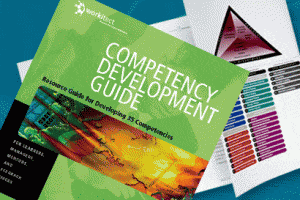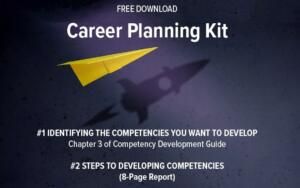Career pathing in its elaborated form is a sophisticated method of developing future managers through the careful assignment of an individual to positions that provide him or her with opportunities for developing the competencies needed for higher-level positions. Workitect’s approach to career pathing combines an analysis of positions in terms of both the tasks and the competencies needed for effective performance. The combined approach is essential for each of the jobs in a career path, because sharp discontinuities sometimes exist between the competencies demanded in one job and those demanded in another in the same career path.
Job-Person Matches

Characteristics of Outstanding Performers
Most career pathing systems used by organizations consider only task-specific job requirements in making job-person matches. When such systems do consider generic personal characteristics beyond knowledge and skills, these characteristics are usually vaguely defined, difficult to assess, and not demonstrably related to outstanding performance. By contrast, Workitect’s competency-based career path analysis avoids these problems. In addition to looking at the requirements for acceptable performance of the specific job tasks, it examines and documents the more general characteristics of outstanding performers—characteristics that are not covered by the analysis of tasks. Moreover, Workitect examines different levels of jobs within an organization, in order to determine both the task and the competency requirements of target jobs and of jobs that feed new talent into the target jobs (“feeder jobs’).
Understanding the task and competency requirements of various jobs helps clarify human resource planning. Although two jobs may have similar task requirements, there may be little overlap in the competencies needed for effective performance. The most commonly cited example of this phenomenon is the transition from salesperson to sales manager—people in these two jobs share tasks, yet the sales-management position demands competencies that are very different from those required by the salesperson’s job.
 In a competency-based career pathing system, the job-task analysis is only part of the picture. It thus contrasts with traditional approaches to career pathing, in which task analysis makes up the entire picture. Naturally, it is important to determine how familiar an individual is with the tasks of a target position. Since even if the person has all the characteristics necessary to be a superior performer, it may take him or her considerable time to master particular tasks. But from an organization systems perspective, any approach based exclusively on task requirements omits a critical part of job performance—characteristics of the individual who performs the job in an outstanding manner. Indeed, it is this factor that is the most powerful predictor of a person’s performance in high-level jobs. Download this report about the entire process of competency-based succession planning.
In a competency-based career pathing system, the job-task analysis is only part of the picture. It thus contrasts with traditional approaches to career pathing, in which task analysis makes up the entire picture. Naturally, it is important to determine how familiar an individual is with the tasks of a target position. Since even if the person has all the characteristics necessary to be a superior performer, it may take him or her considerable time to master particular tasks. But from an organization systems perspective, any approach based exclusively on task requirements omits a critical part of job performance—characteristics of the individual who performs the job in an outstanding manner. Indeed, it is this factor that is the most powerful predictor of a person’s performance in high-level jobs. Download this report about the entire process of competency-based succession planning.
Steps in Developing a Competency-Based Career Pathing System
The major steps in developing a competency-based career pathing system are:
- Put together a resource panel of experts on the target and feeder jobs, who will set direction and specify the job performance criteria that determine who the outstanding performers are.
- Generate task and characteristics, through the resource panel, and survey job incumbents to obtain their perceptions of which job tasks and personal attributes contribute to success in the target job.
- Identify top performers in the target and feeder jobs, using performance criteria specified by the panel.
- Conduct in-depth interviews with both superior and average incumbents in target and feeder jobs, in order to find out what they do and how they do it.
- Develop a task analysis from the interviews, focusing on these tasks and deemed most important by superior performers.
- Develop a competency model of people in the target and the feeder jobs, identifying the competencies that all job performers need, but focusing on those competencies that make the biggest contribution to outstanding performance.
- Analyze career paths by combining the survey and interview results for target and feeder jobs.
- Implement the career pathing system through a number of options:
– Computer-based task and competencies inventories
– Performance appraisal linked to new job opportunities.
– Systematic counseling.
– Career development and related training programs.
The Products of a Career Pathing System
The products of a competency-based career pathing system include:
- A description of the tasks required by target and feeder jobs, broken down by job families.
- A competency model and individual profiles of the outstanding job performers in each target and feeder job.
- Behavioral descriptions of each competency in the model.
- An analysis of job tasks in terms of the competencies that are required to perform them
- Performance indicators that provide the material for a competency-based evaluation program and a computerized skills bank.
- A career map of the organization identifying which jobs are the key feeders to higher-level positions.
- Recommendations for training in or selection for each competency in the model.
- Recommendations for developing a computer-based human resource management system that incorporates the findings of the task, competency, and career path analysis.
Succession Planning and Career Planning
The objective of succession planning is to provide senior management with a system for providing and identifying a pool of ready replacements for key jobs. And to provide professionals with a clearly defined career path and a process to optimize their advancement. We help organizations develop and implement these systems.
Effective talent management, talent development, and career planning contribute directly to the financial performance of an organization. The focus of talent management should be on assessing the competencies the organization needs to implement its strategy, and planning for the recruitment, selection, development, and management of that critical talent. Workitect consultants develop competency frameworks, models, and integrated applications that align with business strategy. Learn more.
Related Blogs
A Competency Model for Career Mobility
The New Reality: Career Streams vs. Career Ladders
Key Concepts of Career Development
It’s your career development – so who should be in the driver’s seat?
Career gold for you in your employer’s talent management process
CONTACT WORKITECT FOR HELP IN DEVELOPING A CAREER PATHING SYSTEM, COMPETENCY MODELS AND COMPETENCY-BASED TALENT MANAGEMENT APPLICATIONS.

Workitect Tools for Assessing, Developing, & Retaining Talent
WORKITECT’S CAREER DEVELOPMENT BUNDLE IS AN INTEGRATED SET OF FIVE PRACTICAL TOOLS (COMPETENCY DEVELOPMENT GUIDE, COMPETENCY INTERVIEW GUIDES, AND COMPETENCY DICTIONARY).
 For additional information, call 800-870-9490, email edward.cripe@workitect.com
For additional information, call 800-870-9490, email edward.cripe@workitect.com
or submit this contact form.
©2024, Workitect, Inc.



Leave A Comment